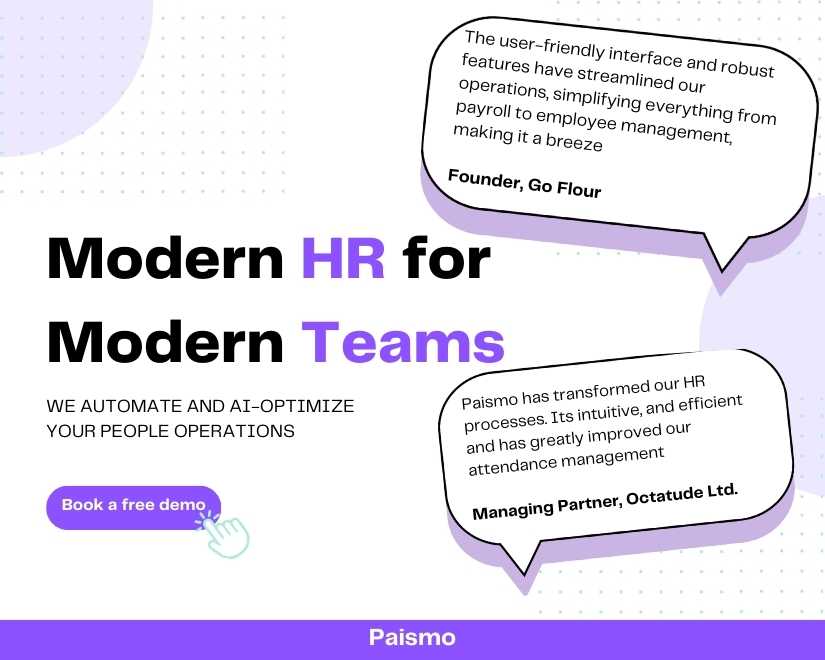Highlights
- Floating holidays are paid days off for personal, cultural, or religious occasions not on the official company calendar.
- Unlike regular PTO, employees select their own floating holiday dates, giving flexibility and supporting diverse needs.
- Benefits include improved work-life balance, cultural inclusion, PTO savings, fair rest, and stronger employee retention.
- Challenges include scheduling conflicts, unclear approval processes, and payroll management for unused floating holidays.
- A clear policy should define eligibility, number of days, request procedures, fairness, and rules for unused days.
Paid time off plays a key role in keeping employees motivated and balanced. Many companies now offer flexible options, such as a floating holiday, giving staff more control over their schedules. If you’ve ever wondered what is floating holiday or wanted to understand the floating holiday meaning. In that case, this guide will help you see how this benefit supports both personal needs and company goals.
In this blog, we cover what are floating holidays, how they work, and why they’re gaining importance in modern workplaces. With smart HRMS tools, tracking and approving leave becomes easier, while advanced HCM systems help build flexible policies that promote employee satisfaction and a stronger workplace culture.
What Is a Floating Holiday?

A floating holiday is a paid day off that employees can take for personal, cultural, or religious events not listed on the company’s official calendar. It adds flexibility and gives employees the freedom to celebrate days that matter to them. For example, if Good Friday isn’t part of the company calendar, an employee can use their floating holiday to observe it. This explains the real floating holiday meaning and how it supports work-life balance.
Some companies extend this benefit for personal needs, such as birthdays or family events. With the help of a learning management system, HR teams can clearly communicate leave policies and guide employees on how to effectively utilize their floating holidays.
Difference Between Floating Holidays and PTO
Both floating holidays and paid time off give employees a break from work, but they serve different purposes. Regular PTO typically includes fixed holidays, vacation days, or sick leave that are scheduled at the beginning of the year. These set days may not reflect everyone’s cultural or personal needs.
In contrast, what are floating holidays can be seen as flexible leave options that let employees choose days that matter most to them. Here’s a quick comparison to understand the key differences:
| Aspect | Floating Holidays | Paid Time Off |
| Use | Personal, cultural, or religious days | Vacation or sick leave |
| Flexibility | Employee selects the date | The company pre-sets dates |
| Inclusivity | Supports diverse preferences | Limited to general holidays |
| Policy | May or may not carry over | Often has fixed limits |
Benefits of Offering a Floating Holiday Policy
In today’s workplace, flexibility is more important than ever. With solutions like Paismo, companies can easily manage floating holiday policies through efficient human capital management tools. Offering floating holidays allows employees to take time off for personal, cultural, or religious occasions while maintaining productivity and balance.
Here’s how this policy benefits your team:
- More flexibility: Employees can pick their own days off, making it easier to manage work and personal life.
- Better retention: People are more likely to stay with a company that values their time and needs.
- Cultural inclusion: It allows everyone to celebrate their traditions and beliefs.
- Saving PTO: Employees can keep their regular paid time off for vacations or sick days.
- Fair rest time: Those who work on standard holidays can take another day off later.
Disadvantages of Floating Holidays
Managing floating holidays can be rewarding, but it also comes with challenges. Without clear policies or guidance from a policy manager, minor issues can easily turn into bigger problems.
Here are some common drawbacks to consider:
- Scheduling conflicts: Employees may take floating holidays during busy periods, which can create staffing gaps and an increased workload for others.
- Employee dissatisfaction: Furthermore, if the approval or tracking process is unclear, some workers may feel that their requests aren’t valued or handled fairly.
- Payroll complications: In addition, managing unused floating holidays on the pay stub can be tricky, especially when payouts are required after an employee leaves the company.
How to Create a Floating Holiday Policy?
Creating a well-structured floating holiday policy helps ensure fairness, clarity, and consistency across the organization. By utilizing the right resources, HR teams can develop policies that strike a balance between employee needs and company goals.
Here’s how to set it up effectively:
Decide the Number Of Floating Holidays
Begin by deciding how many floating holidays employees can use each year. Additionally, consider pro-rating them for new hires who join later in the year. This approach ensures fairness and provides a consistent experience for everyone.
Set Clear Eligibility Criteria
Next, define who is eligible to use floating holidays, including full-time, part-time, and new employees after a specified period. By keeping this information clear, you help avoid confusion and make the policy easier to understand for all parties involved.
Explain When And How to Request
Then, outline when employees can take their floating holidays, such as for cultural, religious, or personal reasons. Be sure to specify how far in advance requests should be made and whether they need manager approval to maintain smooth scheduling.
Ensure Fairness And Inclusion
Make sure your policy treats all employees equally, regardless of their background. By allowing flexibility for various holidays, you promote a respectful and inclusive workplace where everyone feels valued and appreciated.
Clarify Rules For Unused Days
Finally, explain what happens if employees don’t use their floating holidays. For instance, note whether they expire, carry over to the following year, or can be paid out upon someone's departure from the company.
Pro Tip: Utilize digital HR tools to streamline request and approval tracking. This not only saves time but also keeps your floating holiday policy transparent and well-organized.
How Can Employees Request a Floating Holiday?

To request a floating holiday, employees should first verify their available balance via HR or the company’s leave system. Next, they submit a holiday request specifying the date(s) to their supervisor or the HR department. The request is then evaluated based on staffing needs and leave availability. Once approved, the holiday is officially recorded in the system.
Summary
A floating holiday allows employees to take flexible leave for personal, cultural, or religious occasions. Clear policies define eligibility, request procedures, and rules for unused days. Proper management prevents scheduling conflicts and payroll issues. Overall, floating holidays boost employee satisfaction, fairness, and retention.
FAQs
What Is a Floating Holiday?
A floating holiday is a paid day off that employees can use for personal, cultural, or religious occasions, not on the official company holiday list. It adds flexibility and supports work-life balance.
What Are Floating Holidays?
Floating holidays are flexible paid leave days that employees can choose to take for special personal, cultural, or religious events. They allow staff to celebrate days that matter most to them.
What Is Floating Holiday Time Off?
Floating holiday time off is a type of paid leave employees can use for personal, cultural, or non-traditional holidays. It provides flexibility in choosing days off. This allows staff to manage their schedules while observing important events.
Become a part of the Paismo community
Paismo is an HR software that can help simplify your HR operations. In today's dynamic economic environment, efficient HR and automated payroll management are no longer a luxury but a necessity. Paismo is a comprehensive solution that transforms traditional HR complexes into streamlined and automated workflows. Paismo and its paired biometric device integration can be used for your business to mark employee attendance and record their timesheets accurately.
Paismo simplifies your tasks with its core HRMS, timesheets, and attendance management, as well as biometric attendance, payroll automation, and leave management system.

Take the first step toward modernizing your HR and payroll processes and explore what Paismo can do for you. Book a demo with our sales team.










